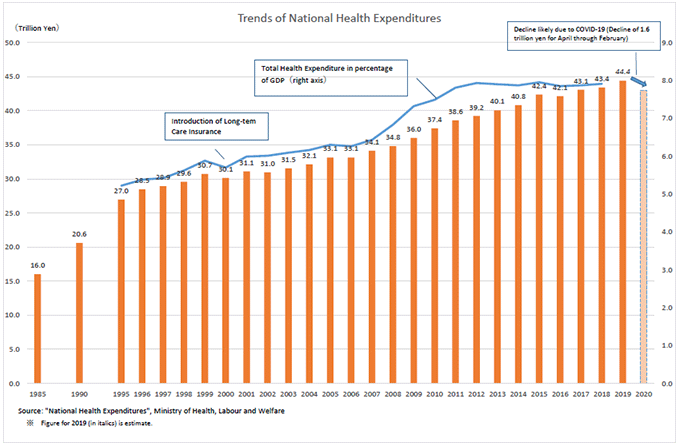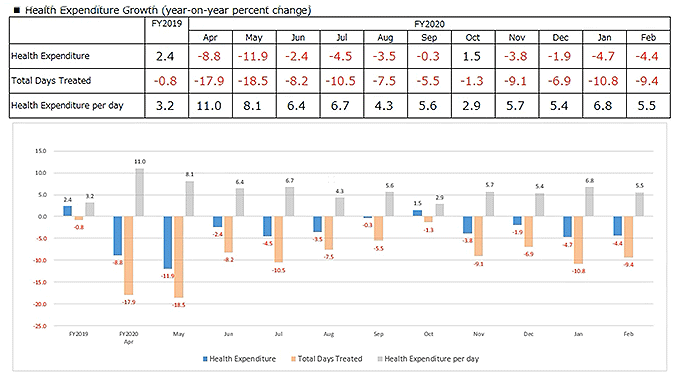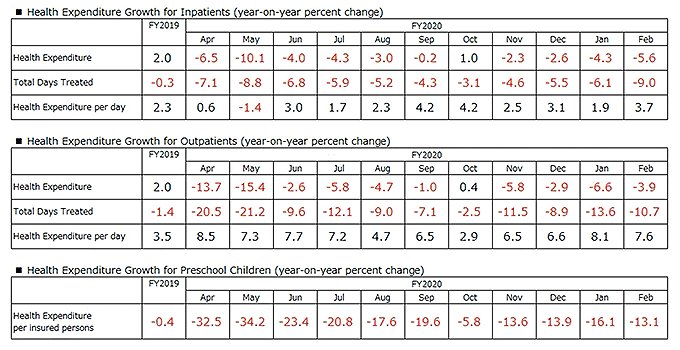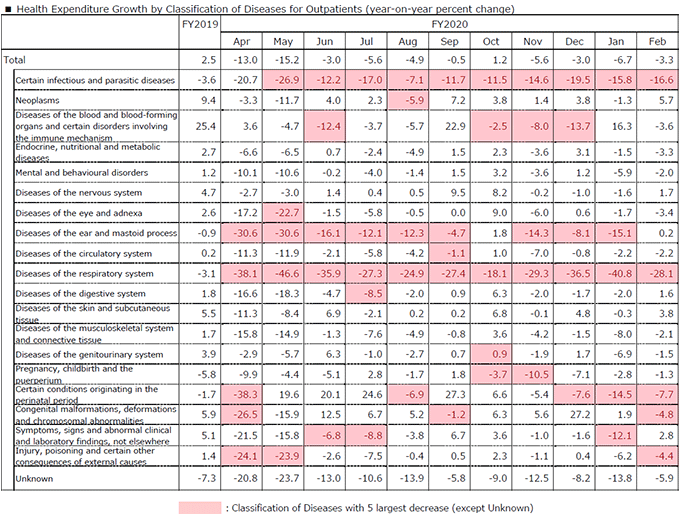This column is based on "Covid-19 and Trends of Health Expenditure" (in Japanese) by Nishioka Takashi, https://www.rieti.go.jp/jp/columns/a01_0647.html
It is now over one year since the beginning of the novel coronavirus pandemic. As people's activities were curbed due to the three declarations of States of Emergency due to COVID-19, there was a large effect on visits to medical institutions. Since severe cases of COVID-19 demand advanced medical care, and with long recovery periods for some patients, COVID-19 is very demanding on medical institutions. We want to express our heartfelt appreciation to all the medical workers who are working hard to cope with COVID-19.
Because of the rapid increase in new infections and news of strained medical resources being often reported, many people may wonder the degree to which demand for health care has increased in Japan. In fact, health expenditure has decreased substantially because decrease in health expenditure from the large changes in people's behavior in terms of willingness to visit medical institutions was far larger than health expenditure on treatment of COVID-19. The Actuarial Research Division of the Health Insurance Bureau at the Ministry of Health, Labour and Welfare (MHLW) reports health expenditure trends as "Trends of Medical Care Expenditure (MEDIAS (Note 1))" on a monthly basis, and it is also reported at the Social Security Council.
Since Universal Health Coverage was introduced in the 1960s, Japan's health expenditures have shown a steady increase along with the aging population. National Health Expenditures in FY2019, which was before COVID-19 started to affect the health care system, was estimated at 44.4 trillion yen, or about 8% of GDP. Historically, National Health Expenditures decreased year-on-year on only 4 occasions (Note 2), with FY2000 seeing the largest decrease of -1.8% or 600 billion yen. This decrease was due to the establishment of long-term care insurance, which replaced some services formerly covered by healthcare insurance (Figure 1). The decrease in health expenditures from the effects of COVID-19 amounted to 1.6 trillion yen from April 2020 to February 2021, and this amount is certain to become largest decrease in health expenditures since the introduction of the health insurance system.
In this column, we will explain the specifics of this trend based mainly on data released within MEDIAS (Note 3).

[Click to enlarge]

[Click to enlarge]
Estimated Health Expenditure decreased sharply year-on-year in April (-8.8%) and May (-11.9%) during the first Declaration of a State of Emergency for COVID-19. Since June, the decrease has become smaller, but we still saw a decrease of -4.4% in February (Figure 2). As health expenditures tends to increase about 2% annually from both the aging of the population and advances in medical treatment in the absence of outside influences such as health insurance reform, the effect from COVID-19 is still ongoing.
MEDIAS data are based on medical fee claim data received from the Health Insurance Claims Review and Reimbursement Services and the Federation of National Health Insurance Associations. Health expenditures can be divided into "total days treated" which shows the frequency of medical treatment, and "health expenditure per day" which shows the density of medical treatment. In May, when data showed the largest decrease year-on-year, inpatient health expenditure growth was -10.1%, of which change in total days treated was -8.8% and change in health expenditure per day was -1.4%. Outpatient health expenditure change in May was -15.4%, of which change in total days treated was -21.2% and change in health expenditure per day was +7.3% (Figure 3). Usually, when frequency of medical treatment decreases, density of medical treatment increases, as with outpatient data. However, for inpatient data in May, as a result of the suspension of new admissions and postponement of non-essential surgeries, both total days treated and health expenditure per day decreased. May was the only month which showed such a notable change, and after June health expenditure per day returned to positive growth year-on-year. As such, it can be surmised that non-essential surgeries in medical institutions have returned gradually since last summer.

Changes in people's behavior in terms of their willingness to visit medical institutions also differs by patient age. Especially, the willingness to seek medical treatment for preschool children saw a significant change in the form of sharp decreases in April (-32.5%) and May (-34.2%), and still shows a decreasing trend in February (-13.1%) (Figure 3). Health expenditures for pediatrics and otorhinolaryngology, for which preschool children are the majority of the patient population, also decreased sharply. This trend may stem not only from the avoidance of medical institutions due to infection risk, but also changes in lifestyle, including increased wearing of masks, washing of hands and gargling having the effect of decreasing the incidence of other infections. For example, based on estimates from reports per fixed observation point from the Infectious Disease Surveillance System, the estimated number of patients who visited medical institutions due to Influenza, which in a normal year is about 10 million, was about 14,000 in the 2020-21 season, representing a record low (Note 4).

[Click to enlarge]
While MEDIAS currently tabulates all medical fee claim data including both paper-based data and electronic form-based data, more detailed tabulations based only on electronic form-based data are included in the report since autumn 2020. This allows for viewing of health expenditures per disease or condition. Health expenditure on diseases of the respiratory system has dropped substantially: -38.1% in April, -46.6% in May, and -28.1% in February (Figure 4). The main reason that health expenditure growth has not returned to normal after waves of infections of COVID-19 is the decrease in expenditure on diseases of the respiratory system, which is still showing negative growth.
According to "Vital Statistics of Japan," mortality in 2020 saw the first decrease (-9,000) in 11 years, and cases where the cause of death was diseases of the respiratory system also decreased. In normal years, mortality increases by around 20,000 due to the increase in the age group with a higher mortality rate due to the aging population. As mortality decreased, life expectancy in 2020 is actually expected to increase sharply. While the more than 10,000 deaths due to COVID-19 in Japan is a tragedy, compared with many countries showing excess mortality (the indicator which shows the difference between mortality from all causes (not limited to infectious disease) with mortality from a reference period) in the hundreds of thousands (Note 5), the effects on life expectancy in Japan were the opposite.
MEDIAS also includes reports of data by prefecture, data on dentistry and prescription drugs, and the details of expenditures are reported on a website (Note 6). When people's activities return to normal due to the widespread use of vaccines, behavior related to visiting medical institutions is expected to return to normal. However, while the numbers for many types of medical visits are likely to return to the pre-COVID-19 normal, there could be some categories of medical visits which are affected by the new lifestyle choices people are making and thus will not return to the pre-COVID-19 normal. Therefore, it will be important to continually analyze detailed data to investigate trends and their causes.



